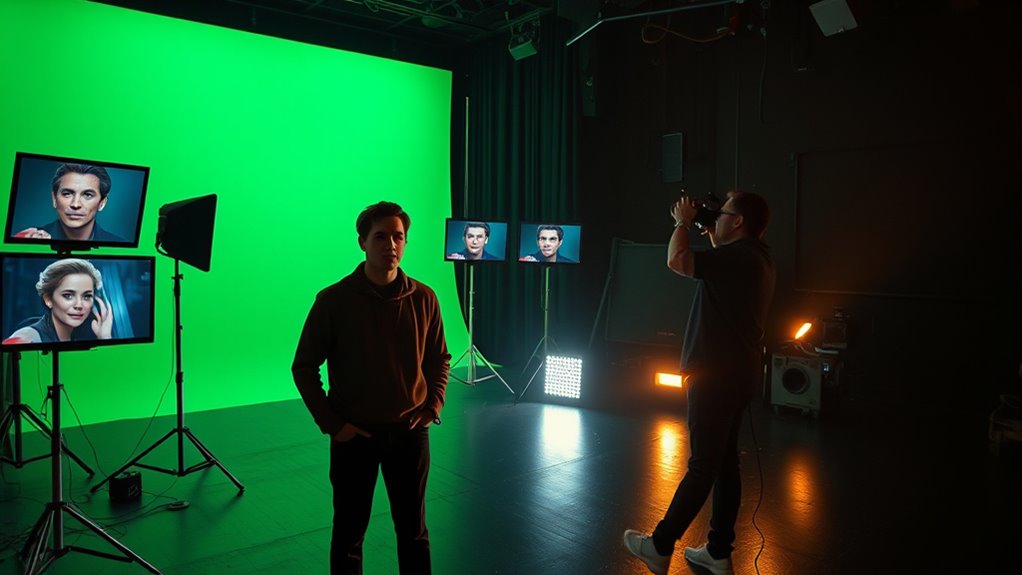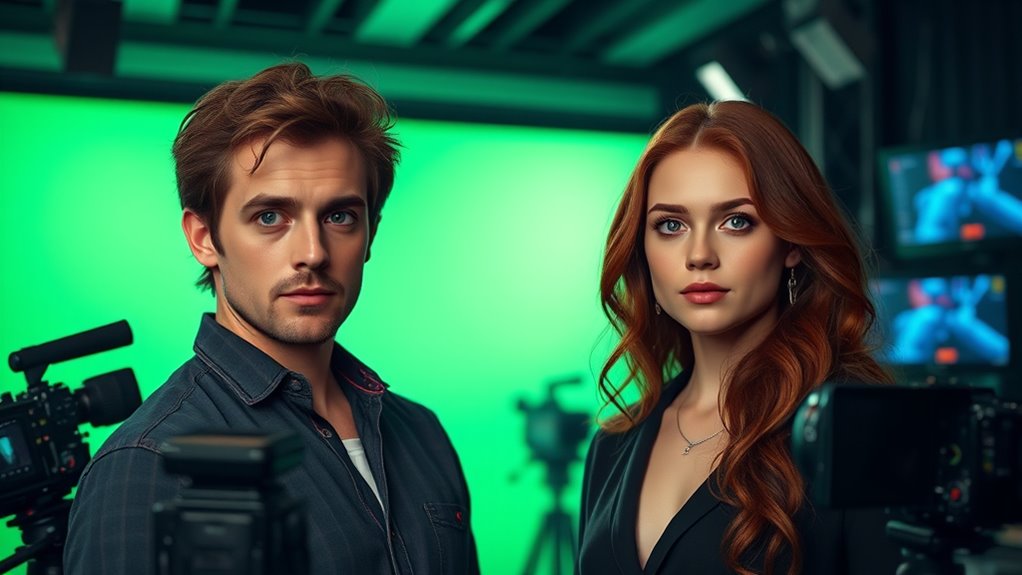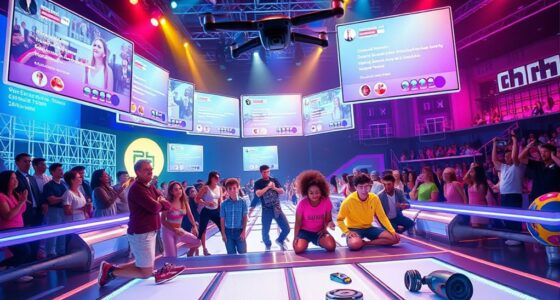Deepfake actors are shaking up Hollywood by blending AI technology with performance art. This innovation allows filmmakers to create stunning stories, using digital avatars to resurrect beloved actors or fill hard-to-cast roles. With AI generating authentic performances, you’re seeing a new wave of creativity and immersive storytelling take shape. However, this shift raises important questions about authenticity and ethics in media. If you’re curious about the broader implications of this technology, there’s more to explore.
Key Takeaways
- Deepfake technology enables the creation of AI-generated avatars that can convincingly mimic real actors, transforming storytelling methods in Hollywood.
- Filmmakers can revive deceased performers or bring back iconic characters, offering fans fresh narratives and innovative experiences.
- The use of deepfake actors raises ethical concerns regarding authenticity and consent, challenging traditional perceptions of performance in film.
- Studios are heavily investing in deepfake technology to remain competitive, indicating a significant shift in the film industry’s creative landscape.
- Audience adaptation is essential as deepfakes blur the lines between reality and fabrication, redefining media consumption and authenticity.

Deepfake actors are revolutionizing the entertainment industry by blending technology and performance in ways we’ve never seen before. You might think of deepfakes as just a novelty, but their impact is profound and far-reaching. These AI-generated avatars can convincingly mimic real actors, allowing filmmakers to create performances that were previously impossible. Imagine watching a new film featuring your favorite actor, even if they’re not actually part of the project. It’s not just a gimmick; it’s a whole new avenue for storytelling.
As you explore this emerging technology, consider how deepfake actors can enhance the viewing experience. They can revive deceased actors, allowing them to star in new films or complete unfinished projects. This technology can bring back iconic performances and allow fans to see characters they love in fresh narratives. You may even find it hard to distinguish between the deepfake and the real thing. This blurring of lines challenges your perception of authenticity and opens up discussions about the ethics of using someone’s likeness without their consent.
Moreover, deepfake actors can fill roles that may otherwise remain uncast. If a character requires a specific look or age that’s hard to find, AI can step in to create a perfect match. You’ll see directors harnessing this power to push creative boundaries and enhance production values. It’s a chance for you to witness stories told in innovative ways, with unique visual styles that captivate audiences.
However, the rise of deepfake actors isn’t without its controversies. As you explore this world, you’ll encounter concerns about misinformation and the potential for misuse. The technology can easily be manipulated to create fake news or misleading content. It’s vital for you to remain vigilant and discerning, as the line between reality and fabrication becomes increasingly blurred.
The conversation around deepfake actors isn’t just about technology; it’s about the future of the film industry itself. You’ll find that studios are investing heavily in deepfake technology, aiming to stay ahead in a rapidly evolving market. As a viewer, you’ll need to adapt to these changes, embracing the new possibilities while also questioning the implications of this technology. Deepfake actors are here to stay, and they’re reshaping Hollywood in ways you never thought possible. You’re witnessing the dawn of a new era, one that challenges conventions and redefines what it means to perform on screen. Additionally, the impact of animated films has been significant, as they often utilize cutting-edge technologies to enhance storytelling in ways similar to deepfake actors.
Frequently Asked Questions
How Do Deepfake Technologies Work in Filmmaking?
Deepfake technologies work in filmmaking by using artificial intelligence to create realistic digital replicas of actors. It analyzes existing footage to learn facial movements and expressions, then generates new scenes with these synthetic faces. You can seamlessly replace an actor’s face or create entirely new performances, enhancing storytelling. This tech allows filmmakers to revive past stars or experiment with performances, all while pushing the boundaries of visual effects and audience engagement in unique ways.
Are Deepfake Actors Ethically Acceptable in Hollywood?
You might find deepfake actors ethically acceptable if they enhance storytelling and respect the rights of original performers. However, concerns about consent and authenticity can’t be ignored. It’s vital to take into account whether the technology misleads audiences or exploits actors. If used transparently and responsibly, deepfakes could offer new creative avenues, but they also risk undermining trust in film. Ultimately, it’s about balancing innovation with ethical considerations in the industry.
Can Deepfake Technology Replace Human Actors Entirely?
Imagine a world where pixels dance and tell stories without human touch; deepfake technology can’t fully replace human actors. While it can enhance performances, you’ll miss the raw emotion and spontaneity that only real actors bring. Audiences crave authenticity, and the magic of a live performance is irreplaceable. Deepfake can complement artistry, but it lacks the heart and soul that make storytelling truly resonate with viewers. Embrace both, but cherish the human element.
What Legal Issues Surround the Use of Deepfake Actors?
When using deepfake actors, you’ll face several legal issues. Copyright concerns arise if you use someone’s likeness without permission. You might also encounter defamation risks if the deepfake misrepresents someone. Additionally, ethical considerations come into play, especially regarding consent and the potential for misinformation. It’s essential to navigate these legal landscapes carefully, as regulations are evolving, and what’s permissible today might not be tomorrow. Always seek legal advice before proceeding.
How Can Audiences Differentiate Between Real and Deepfake Performances?
When it comes to spotting the difference between real and deepfake performances, you’ve gotta keep your wits about you. Look for subtle cues like unnatural facial movements, inconsistent lighting, or odd emotional expressions. Pay attention to voice quality and syncing; deepfakes often struggle there. Also, stay informed about the latest technology trends, as awareness can help you catch things that seem off. Trust your instincts; if it feels fake, it probably is.
Conclusion
As you navigate the evolving landscape of Hollywood, consider the juxtaposition of authenticity and artifice. Deepfake actors blur the lines between reality and illusion, offering unprecedented creative possibilities while raising ethical questions. You might marvel at the stunning realism of AI-generated performances, yet feel a twinge of unease about the implications for genuine human expression. Ultimately, it’s a thrilling, yet formidable, frontier that invites you to reflect on what it truly means to be an actor in this digital age.









